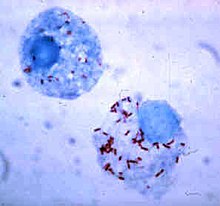| Rickettsia rickettsii | |
|---|---|

| |
| Scientific classification | |
| Domain: | Bacteria |
| Phylum: | Pseudomonadota |
| Class: | Alphaproteobacteria |
| Order: | Rickettsiales |
| Family: | Rickettsiaceae |
| Genus: | Rickettsia |
| Species group: | Spotted fever group |
| Species: | R. rickettsii
|
| Binomial name | |
| Rickettsia rickettsii Brumpt, 1922
| |
Rickettsia rickettsii is a Gram-negative, intracellular, coccobacillus bacterium that was first discovered in 1902.[1] Having a reduced genome, the bacterium harvests nutrients from its host cell to carry out respiration, making it an organoheterotroph. Maintenance of its genome is carried out through vertical gene transfer where specialization of the bacterium allows it to shuttle host sugars directly into its TCA cycle.[2]
Other characteristics of the bacteria include membrane proteins that are useful in the identification of R. rickettsii strains and useful in the targeting of antibiotics. A capsule encircling the bacterium allows for attachment to host cells and additionally acts as a defense mechanism for resisting phagocytosis. Varying strains of R. rickettsii have different genotypes and phenotypes that alter the pathogenicity, virulence, and appearance of the bacteria.[3][4][5]
R. rickettsii is the causative agent of Rocky Mountain Spotted Fever and is transferred to its host via a tick bite. It is one of the most pathogenic Rickettsia species[6] and affects a large majority of the Western Hemisphere, most commonly the Americas.[7] The pathogenic agent has been found on every continent, except Antarctica; however, Rocky Mountain Spotted Fever occurs mostly in North, Central, and South America.[7] This prevalence is due to R. rickettsi thriving in warm, damp environments.[8] These environments provide sufficient conditions for the amplification of the bacteria within a vertebrate host, such as a horse or dog. The bacteria are transmitted through the vector, a tick, to a vertebrate host where it can then be amplified and passed on to a person, resulting in the zoonotic disease.[9]
Headache, high fever, and spotted rash are some effects of the disease with more severe cases resulting in organ damage and coma.[10][11][12] Antibiotics, such as doxycycline, target the ribosome of R. rickettsii in order to inhibit protein synthesis of the bacteria, providing a form of treatment for the disease.[13]
- ^ Patel S, Pedroza LV (2023-06-13). Bronze MS (ed.). "Rocky Mountain Spotted Fever (RMSF): Background, Etiology and Pathophysiology, Epidemiology". Medcape.
- ^ Driscoll TP, Verhoeve VI, Guillotte ML, Lehman SS, Rennoll SA, Beier-Sexton M, et al. (September 2017). "Wholly Rickettsia! Reconstructed Metabolic Profile of the Quintessential Bacterial Parasite of Eukaryotic Cells". mBio. 8 (5): e00859–17. doi:10.1128/mBio.00859-17. PMC 5615194. PMID 28951473.
- ^ Cite error: The named reference
Gong_2015was invoked but never defined (see the help page). - ^ Cite error: The named reference
Clark_2015was invoked but never defined (see the help page). - ^ Clark TR, Ellison DW, Kleba B, Hackstadt T (April 2011). Morrison RP (ed.). "Complementation of Rickettsia rickettsii RelA/SpoT restores a nonlytic plaque phenotype". Infection and Immunity. 79 (4): 1631–7. doi:10.1128/IAI.00048-11. PMC 3067566. PMID 21300770.
- ^ Hackstadt T. "Biology of Rickettsia".
- ^ a b Conover MR, Vail RM (2014). "Rocky Mountain Spotted Fever and Other Spotted Fevers". Human Diseases from Wildlife. CRC Press. pp. 252–265. doi:10.1201/b17428-18. ISBN 978-0-429-10009-3. Retrieved 2023-10-31.
- ^ Parola P, Paddock CD, Raoult D (October 2005). "Tick-borne rickettsioses around the world: emerging diseases challenging old concepts". Clinical Microbiology Reviews. 18 (4): 719–756. doi:10.1128/CMR.18.4.719-756.2005. PMC 1265907. PMID 16223955.
- ^ Labruna MB (May 2009). "Ecology of rickettsia in South America". Annals of the New York Academy of Sciences. 1166 (1): 156–166. Bibcode:2009NYASA1166..156L. doi:10.1111/j.1749-6632.2009.04516.x. PMID 19538276.
- ^ Cite error: The named reference
American Academy of Pediatrics_2018was invoked but never defined (see the help page). - ^ Cite error: The named reference
CDC_2019was invoked but never defined (see the help page). - ^ Cite error: The named reference
Drexler_2020was invoked but never defined (see the help page). - ^ Cite error: The named reference
Holmes_2009was invoked but never defined (see the help page).